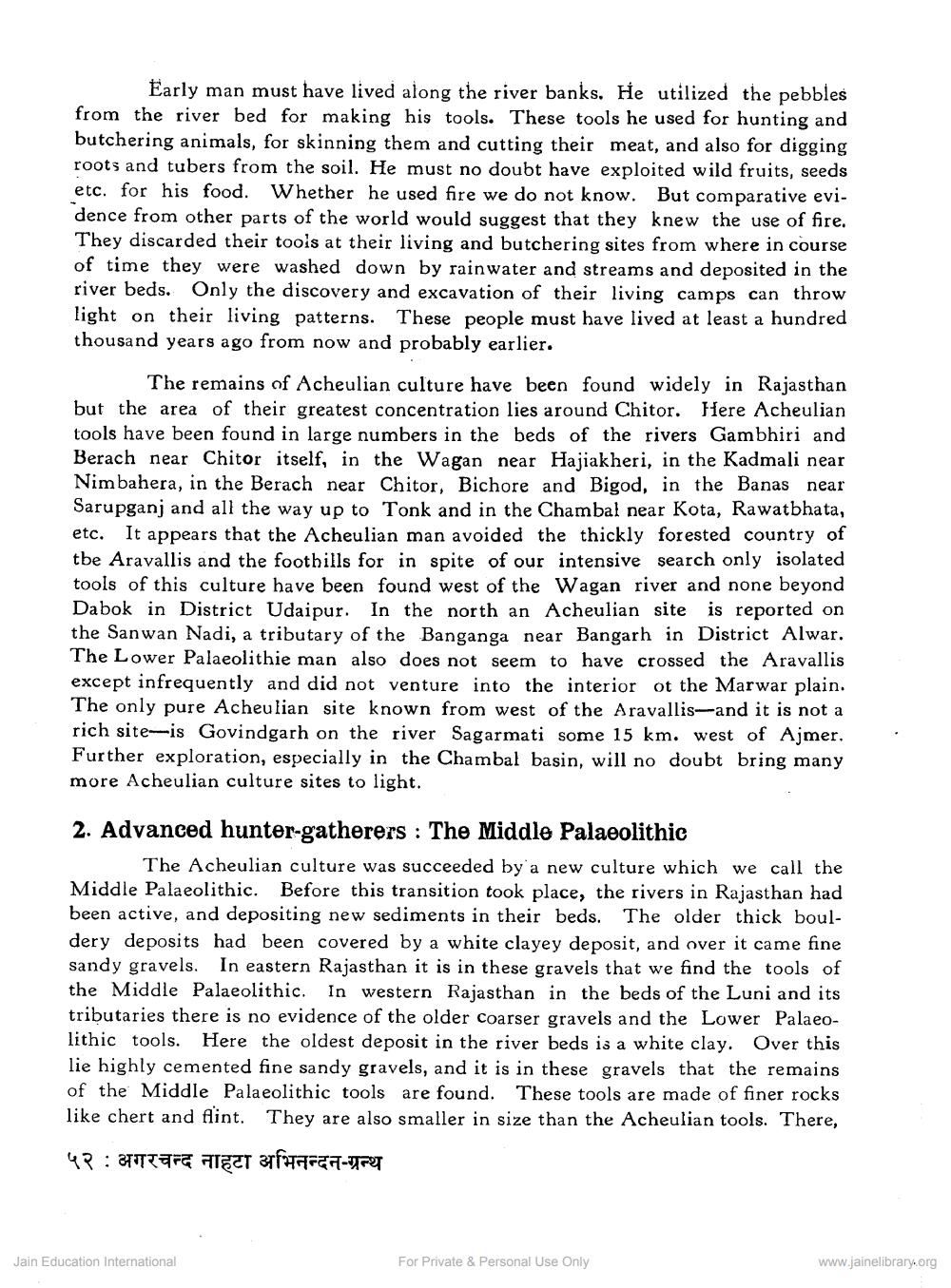Book Title: Prehistoric Background of Rajasthan Culture Author(s): V N Misra Publisher: Z_Agarchand_Nahta_Abhinandan_Granth_Part_2_012043.pdf View full book textPage 4
________________ Early man must have lived along the river banks. He utilized the pebbles. from the river bed for making his tools. These tools he used for hunting and butchering animals, for skinning them and cutting their meat, and also for digging roots and tubers from the soil. He must no doubt have exploited wild fruits, seeds etc. for his food. Whether he used fire we do not know. But comparative evidence from other parts of the world would suggest that they knew the use of fire. They discarded their tools at their living and butchering sites from where in course of time they were washed down by rainwater and streams and deposited in the river beds. Only the discovery and excavation of their living camps can throw light on their living patterns. These people must have lived at least a hundred thousand years ago from now and probably earlier. etc. The remains of Acheulian culture have been found widely in Rajasthan. but the area of their greatest concentration lies around Chitor. Here Acheulian tools have been found in large numbers in the beds of the rivers Gambhiri and Berach near Chitor itself, in the Wagan near Hajiakheri, in the Kadmali near Nimbahera, in the Berach near Chitor, Bichore and Bigod, in the Banas near Sarupganj and all the way up to Tonk and in the Chambal near Kota, Rawatbhata, It appears that the Acheulian man avoided the thickly forested country of the Aravallis and the foothills for in spite of our intensive search only isolated tools of this culture have been found west of the Wagan river and none beyond Dabok in District Udaipur. In the north an Acheulian site is reported on the Sanwan Nadi, a tributary of the Banganga near Bangarh in District Alwar. The Lower Palaeolithie man also does not seem to have crossed the Aravallis except infrequently and did not venture into the interior ot the Marwar plain. The only pure Acheulian site known from west of the Aravallis-and it is not a rich site is Govindgarh on the river Sagarmati some 15 km. west of Ajmer. Further exploration, especially in the Chambal basin, will no doubt bring many more Acheulian culture sites to light. 2. Advanced hunter-gatherers: The Middle Palaeolithic The Acheulian culture was succeeded by a new culture which we call the Middle Palaeolithic. Before this transition took place, the rivers in Rajasthan had been active, and depositing new sediments in their beds. The older thick bouldery deposits had been covered by a white clayey deposit, and over it came fine sandy gravels. In eastern Rajasthan it is in these gravels that we find the tools of the Middle Palaeolithic. In western Rajasthan in the beds of the Luni and its tributaries there is no evidence of the older coarser gravels and the Lower Palaeolithic tools. Here the oldest deposit in the river beds ia a white clay. Over this lie highly cemented fine sandy gravels, and it is in these gravels that the remains of the Middle Palaeolithic tools are found. These tools are made of finer rocks like chert and flint. They are also smaller in size than the Acheulian tools. There, ५२: अगरचन्द नाहटा अभिनन्दन ग्रन्थ Jain Education International For Private & Personal Use Only www.jainelibrary.orgPage Navigation
1 2 3 4 5 6 7 8 9 10 11 12 13 14 15 16 17 18 19
